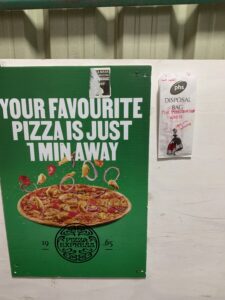Working with the Found Object
Primary research
In this project I worked with an object found in my accommodation and public bathrooms: Disposal Bags. It caught my interest because I didn´t know about them and had an interesting detail: the image of a Victorian lady. I believe this is a symbol of the female stereotype and relates to the concept of shame associated with menstruation.
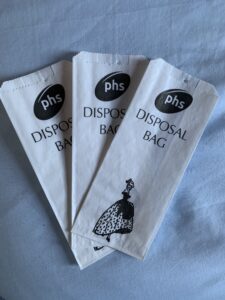
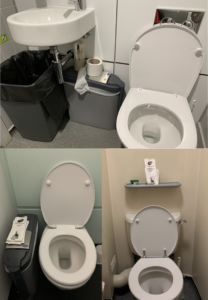 Disposal bags in accommodation and public bathrooms (Self-authored photographs)
Disposal bags in accommodation and public bathrooms (Self-authored photographs)
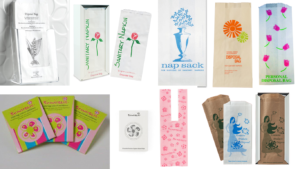
Disposals bags founded on internet where the pattern of drawings associated with a delicate femininity is repeated (Self-authored collage).
The first approach to the project was to use the bag to hide any element of the city that embarrasses us. Although, after the discussing sessions, I decided to focus on the bag and its original purpose, because is an object use to hide menstruation even when nobody is seen it.
I experimented by intervening the bags with messages making their purpose more explicit and introducing messages inside them with menstrual-related content.


Experimentation on Disposal Bags (Self-authored photographs). Text on the messages inside was wrote based in this sources: Medine plus; NHS; HOPE; Hello Clue.
Secondary research
JANNIS KOUNELLIS (Greece) (1936 – 2017) / Arte Povera`s artist
Kounellis presents objects and elements in a way that allow them to exist in a totally new perspective, where “everything and anything had the potential to be seen, regardless of its aesthetic or perceived use-value”[1].
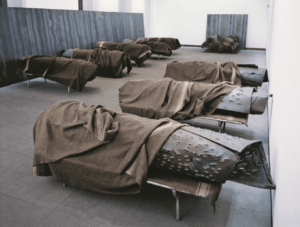
Untitled (2000). 13 military hospital beds; 11 steel forms; 19 steel plates; 35 military blankets (Source: https://www.artbasel.com/catalog/artwork/85806/Jannis-Kounellis-Untitled)
ROSELLA BISCOTTI (Italy) (1968-) / Multimedia artist
Biscotti cross the boundaries of what could be considered as art, taking everyday elements from the past and the present, to transform them in a piece of art with a powerful message that allows the audience to deeply question some concepts that we take for granted.

Yellow Movie (2010). Film projection. Assembles a yellow frame with an audio work edited from recordings of controversial psychoanalytic sessions. Photo by: Hugo Muñoz (Source: https://wilfriedlentz.com/work/yellow-movie-2010/)
NICANOR PARRA (Chile) (1914-2018) / Anti-Poet
He made (anti) installations with found objects and words, giving the object a new meaning through this juxtaposition.
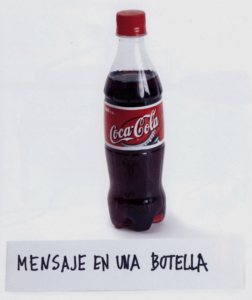

Practical work collection (1996-2002). Image 1: Message in a bottle; Image 2: I`ll be back soon (Source: http://www.memoriachilena.gob.cl/archivos2/pdfs/MC0013511.pdf).
Australian marketing campaign (2010)
This billboard was intentionally vandalized adding hair and changing the text over a perfume advertising, transforming it into something different and playing with the male stereotype.

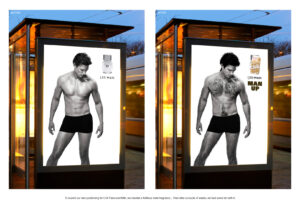 (Source: https://www.adsoftheworld.com/media/outdoor/chill_les_man_adshel)
(Source: https://www.adsoftheworld.com/media/outdoor/chill_les_man_adshel)
FINAL WORK: YES, I`M BLEEDING
Finally, I decided to go on with the previous experimentation and intervene the bags with messages explicitly talking about menstruation inside and outside them. These were written with markers and pens. Also, I painted the lady´s dress to resemble the blood.

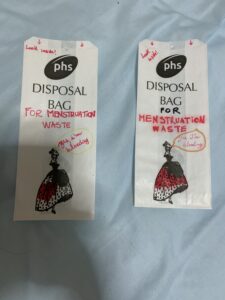
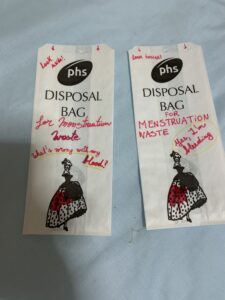
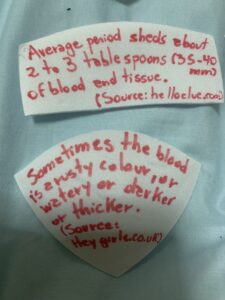

Intervened bag photos (Self-authored photographs).
I placed them in locations throughout Edinburgh city, like bus stop and other crowded places. The aim was to take the bags out of their private place, the women`s bathroom, to public space involving citizens in the intervention by making them react to the object.
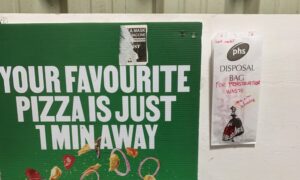

Bags placed in the city (Self-authored photographs)
The day after, the bags appeared to have been opened and some of the messages inside had been taken out. One of them was removed from the site, which can indicate rejection to the message in the bags. I considered the intervention successful with respect to the objective of the work. However, to make a greater impact I could have recreated the bags in a larger size.
[1] Thorne, H. (2019, June 7th). Jannis Kounellis: A Taxonomy of Tired Things. Recovered from https://www.frieze.com/article/jannis-kounellis-taxonomy-tired-things
Making and Breaking Narratives
Primary research
In this work I opted to work with narratives related to my nationality and how Chile is represented abroad, because in Edinburgh I have talked with a wide range of people, and I noticed that they have some bias and do not know much about Chile. In addition, the UK government site has a section called foreign travel advice: CLICK HERE TO SEE THE WEBSITE; where the information about Chile is quite exaggerated.

Example of exaggerated information (Image source: https://www.gov.uk/foreign-travel-advice/chile).
On the other hand, Chile shows itself abroad as a country with wonderful landscapes and a culture isolated from the daily life of its inhabitants. As is shown in this video from the chilean Sub-secretariat of Tourism (https://www.youtube.com/watch?v=DR51pgjWXi8):
In addition, I asked people close to me what is the first thought they have when they listen to the word Chile.


Answers obtained to the question made on my Instagram platform: “F*ck Chile”; “It has a little bit of everything and the craziest people in the world live there!!”; “Mountains”; “Piscola [chilean typical drink]“; “I want to get out of hereeee jajajajajaja”; “Food”; “Take me away”; “Family…specially when I was in the USA”; “All the times I have said no more Chile”; “F*ck country”.
Regarding to all the above, my first attempt was to experiment juxtaposing some views through a collage.
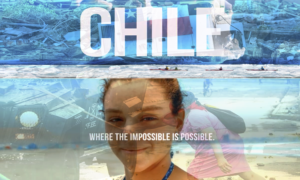
Experimental collage made with screencaps from the above video and famous images of Chile´s 2010 earthquake and 2019 protests (Self-authored collage).
Original images:

Chile`s 2010 Earthquake and Tsunami (Source: https://cnnespanol.cnn.com/2018/09/28/10-cosas-unicas-de-chile/)
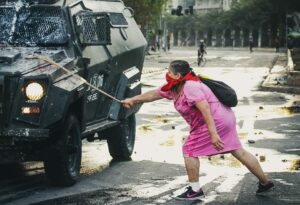
Chile`s 2019 riots (Source: https://www.primeralineaprensa.cl/?p=3744)
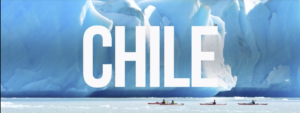
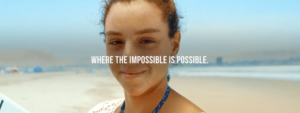
Screencaps from Chile, where the impossible is possible (Source: https://www.youtube.com/watch?v=DR51pgjWXi8&t=1s)
Secondary Research
Jesse Jones (Ireland) (1978-) / Contemporary multimedia artist
Jones mixes film, performance, installation, and collective structures to explore, question and challenge historical narratives in culture through current concepts [2]. A remarkable element in her works is the re-script or re-enact from previous films or dramatic works to give them a new look from today’s perspective.
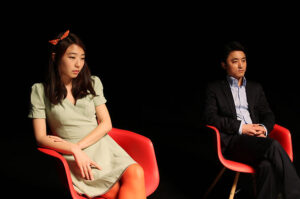

The Other North (2013). Film where South Korean people re-enact therapy sessions held by an American psychologist in the 1970s in Northern Ireland (Source: https://www.jessejonesartist.com).
Alberta Whittle (Barbados) (1980-) / Multimedia artist, researcher, and curator
Whittle explores concepts as racism, colonialism, inclusion, and diversity using film, collage, installation, sculpture and founded objects. Her work allows the viewers to question the society and themselves to battle xenophobia and racism through challenging mainstream narratives [3].
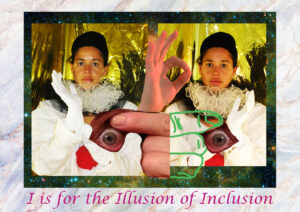

Business as Usual (2020). Collage with juxtaposed images of body, culture, and stereotypes about them. It challenges the narrative of power about inclusion (Source: https://www.albertawhittle.com/business-as-usual.html)
FINAL WORK: JUXTAPOSE
For this project I made an audiovisual piece juxtaposing images, text and sound of the video Chile, where the impossible…. (idealised view of Chile), with audio-visual footage of the country from a range of sources (other narratives from people and alternative media), and text from UK government website (narrative from another country). The elements sometimes are in accordance and sometimes are totally contrary, challenging what is being said by the official voices. This aims not only to question but also to broaden the narratives on and from Chile.
Final video / Juxtapose
(https://vimeo.com/696029131)
[3] Paik, S. (2018). Jesse Jones. https://ocula.com/artists/jesse-jones/
[4] Alberta Whittle. (n. d.). Biography. https://www.albertawhittle.com/biography.html
Mapping the Soundscape
Primary research
In this project I made an exploration in two city spaces: the court my window overlooks and Dublin during Saint Patrick`s Day weekend.
From my window
I live in Edinburgh city centre close to the Royal Mile where a lot of people walk around by day and night. I thought this could be interesting because I hear a wide variety of sounds related to live in a city, as drunk people, birds, ambulances, tourists, etc.
SoundCloud playlist with the sounds without edition:
(https://soundcloud.com/maria-francisca-escobar-nachar/sets/from-my-window)
St. Patrick´s Day
I went to Dublin from 17th to 21th March and recorded many sounds related to St. Patrick`s day. I was interested in all the sounds that could be part of the festivity atmosphere. But as the weekend passed, I realised that the festivities were not all over the place and I looked for other things to do and hear in the city, visiting beaches and surrounding towns.
SoundCloud playlist with some of the sounds without edition:
(https://soundcloud.com/maria-francisca-escobar-nachar/sets/st-patricks-feelings)
Secondary research
London Unseen (2008-2020)
These soundmaps are hosted in London Sound Survey (https://www.soundsurvey.org.uk/), website with a sound collection of everyday life in London through the years. I found remarkable that the authors do not tell the auditors about the places where the sounds came from, so they must pay attention to guess what the location is or imagine it.
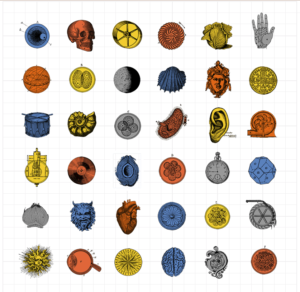
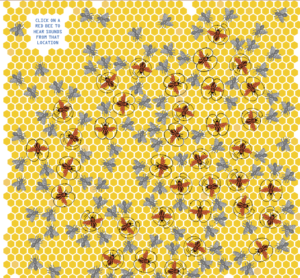
Two sound maps where the sounds are associated with images (Source: https://www.soundsurvey.org.uk/index.php/london_unseen/pitcairn)
Two layers of cake (2020)
http://acts-of-air.crisap.org/two-layers-of-cake.html
Created by Yara Mekawei (Egypt, 1987-), music and sound artist, the work is part of Acts of Air: Reshaping the urban sonic. This work presents several layers of sounds recorded in Old Cairo along the year. The work invite the auditors to become part of a sound walk hearing the audios in their own environment. I found fascinating how in each auditor who listens to it a new sound construction is generated in situ.
FINAL WORK: ST. PATRICK`S FEELINGS
After the discussion sessions and research, I decided to work with the Dublin sounds. I made a proposal for a sound walk where the auditor is invited to travel with me to the city during the festivities.
The first aim is to visit through sound the most crowded places, feeling the music and the party, but also the moments of tension and escape from the noise of the city. The second aim is to build connections and reflections between the places where the listener is located and the sounds they hear. For this the auditor must follow the indications:
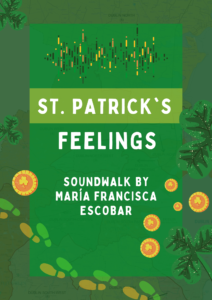
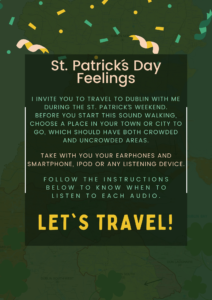
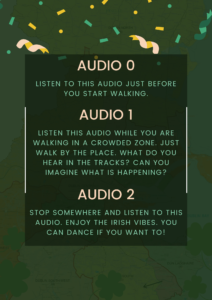

(Orginal file: https://drive.google.com/file/d/1b-fhz1gFnTykx7d8cpA7ChzzDoDyCyyA/view?usp=sharing)
The sound walk is available at the following site and is freely accessible to anyone who wants to experience it:
https://624dc6fd58d2a.site123.me/
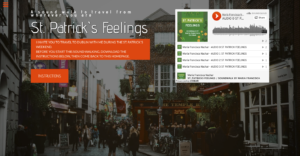
Screen capture from the site (Self-authored)
On this occasion it was not possible for me to collect experiences from people who did the sound walk. In this way, the analysis of the audience`s reception is a pending challenge.


